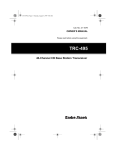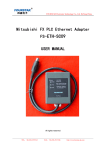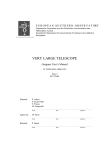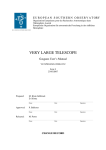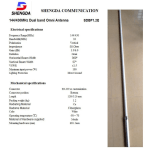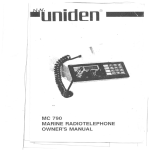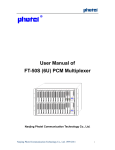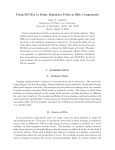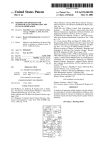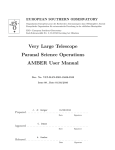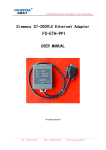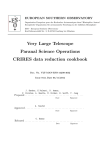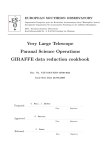Download Amber
Transcript
EUROPEAN SOUTHERN OBSERVATORY Organisation Européenne pour des Recherches Astronomiques dans l’Hémisphère Austral Europäische Organisation für astronomische Forschung in der südlichen Hemisphäre VERY LARGE TELESCOPE AMBER Pipeline User Manual VLT-MAN-ESO-19500-XXXX Issue 0.8 Date 2006-09-18 Prepared: .ESO . . . . . .AMBER . . . . . . . .Pipeline . . . . . . . . . . . .Team . . . . . . . . .2006-09-18 ........................................ Name Approved: Signature .P.Ballester, . . . . . . . . . . . . . . . . . .M. . . . .Peron ..................................................... Name Released: Date Date Signature .P. . . . . Quinn ....................................................................... Name Date Signature This page was intentionally left blank ESO Doc: Issue: Date: Page: AMBER Pipeline User Manual VLT-MAN-ESO-19500-XXXX Issue 0.8 Date 2006-09-18 3 of 46 Change record Issue/Rev. 1.0 Date 09/07/2004 Section/Parag. affected All Reason/Initiation/Documents/Remarks First version This page was intentionally left blank ESO AMBER Pipeline User Manual Doc: Issue: Date: Page: VLT-MAN-ESO-19500-XXXX Issue 0.8 Date 2006-09-18 5 of 46 Contents 1 Introduction 9 1.1 Purpose . . . . . . . . . . . . . . . . . . . . . . . . . . . . . . . . . . . . . . . . . . . . . . . 9 1.2 Acknowledgements . . . . . . . . . . . . . . . . . . . . . . . . . . . . . . . . . . . . . . . . . 9 1.3 Scope . . . . . . . . . . . . . . . . . . . . . . . . . . . . . . . . . . . . . . . . . . . . . . . . 9 1.4 Applicable documents . . . . . . . . . . . . . . . . . . . . . . . . . . . . . . . . . . . . . . . 9 1.5 Reference documents . . . . . . . . . . . . . . . . . . . . . . . . . . . . . . . . . . . . . . . . 9 1.6 Abbreviations and acronyms . . . . . . . . . . . . . . . . . . . . . . . . . . . . . . . . . . . . 10 1.7 Glossary . . . . . . . . . . . . . . . . . . . . . . . . . . . . . . . . . . . . . . . . . . . . . . . 10 2 Overview 11 3 AMBER Instrument Description 12 4 3.1 Overview . . . . . . . . . . . . . . . . . . . . . . . . . . . . . . . . . . . . . . . . . . . . . . 12 3.2 Observation Modes . . . . . . . . . . . . . . . . . . . . . . . . . . . . . . . . . . . . . . . . . 13 3.3 Angular Resolution . . . . . . . . . . . . . . . . . . . . . . . . . . . . . . . . . . . . . . . . . 13 3.4 Flux Sensitivity . . . . . . . . . . . . . . . . . . . . . . . . . . . . . . . . . . . . . . . . . . . 14 3.5 Field Of View . . . . . . . . . . . . . . . . . . . . . . . . . . . . . . . . . . . . . . . . . . . . 15 Instrument Data Description 16 4.1 Calibration Frames . . . . . . . . . . . . . . . . . . . . . . . . . . . . . . . . . . . . . . . . . 16 4.2 Scientific Frames . . . . . . . . . . . . . . . . . . . . . . . . . . . . . . . . . . . . . . . . . . 18 5 Ancillary Data Description 20 6 Data Reduction 21 6.1 Reduction Cascade . . . . . . . . . . . . . . . . . . . . . . . . . . . . . . . . . . . . . . . . . 21 6.2 AMBER pipeline recipes . . . . . . . . . . . . . . . . . . . . . . . . . . . . . . . . . . . . . . 21 6.3 Set of frames . . . . . . . . . . . . . . . . . . . . . . . . . . . . . . . . . . . . . . . . . . . . 22 6.4 Recipe configuration . . . . . . . . . . . . . . . . . . . . . . . . . . . . . . . . . . . . . . . . 23 6.5 Running a recipe using EsoRex . . . . . . . . . . . . . . . . . . . . . . . . . . . . . . . . . . . 23 6.6 Running a complete data reduction using GASGANO . . . . . . . . . . . . . . . . . . . . . . . 25 ESO AMBER Pipeline User Manual Doc: Issue: Date: Page: VLT-MAN-ESO-19500-XXXX Issue 0.8 Date 2006-09-18 6 of 46 6.7 Creating a primary FITS-Image of the Channels . . . . . . . . . . . . . . . . . . . . . . . . . 25 6.8 Calculating the Pixel-To-Visibility-Matrix . . . . . . . . . . . . . . . . . . . . . . . . . . . . . 27 6.9 Calculating the scientific results . . . . . . . . . . . . . . . . . . . . . . . . . . . . . . . . . . 28 6.10 Plotting the scientific results . . . . . . . . . . . . . . . . . . . . . . . . . . . . . . . . . . . . 29 7 Pipeline Recipes Interfaces 31 7.1 amber-raw-to-fitsimage . . . . . . . . . . . . . . . . . . . . . . . . . . . . . . . . . . . . . . . 31 7.2 amber-detector . . . . . . . . . . . . . . . . . . . . . . . . . . . . . . . . . . . . . . . . . . . 32 7.3 amber-beampos . . . . . . . . . . . . . . . . . . . . . . . . . . . . . . . . . . . . . . . . . . . 32 7.4 amber-p2vm . . . . . . . . . . . . . . . . . . . . . . . . . . . . . . . . . . . . . . . . . . . . . 33 7.5 amber-SciCal . . . . . . . . . . . . . . . . . . . . . . . . . . . . . . . . . . . . . . . . . . . . 34 7.6 amber-selector . . . . . . . . . . . . . . . . . . . . . . . . . . . . . . . . . . . . . . . . . . . . 34 7.7 amber-divider . . . . . . . . . . . . . . . . . . . . . . . . . . . . . . . . . . . . . . . . . . . . 36 8 Product Data Description 38 8.1 Intermediate Products . . . . . . . . . . . . . . . . . . . . . . . . . . . . . . . . . . . . . . . . 38 8.2 Scientific Products . . . . . . . . . . . . . . . . . . . . . . . . . . . . . . . . . . . . . . . . . 38 9 Algorithms 9.1 9.2 39 General Algorthms . . . . . . . . . . . . . . . . . . . . . . . . . . . . . . . . . . . . . . . . . 39 9.1.1 Dark subtraction . . . . . . . . . . . . . . . . . . . . . . . . . . . . . . . . . . . . . . 39 9.1.2 Flat field correction . . . . . . . . . . . . . . . . . . . . . . . . . . . . . . . . . . . . . 39 9.1.3 fringe search . . . . . . . . . . . . . . . . . . . . . . . . . . . . . . . . . . . . . . . . 39 Recipes Algorithms . . . . . . . . . . . . . . . . . . . . . . . . . . . . . . . . . . . . . . . . . 39 9.2.1 A Installation recreation of active CCD sensor area . . . . . . . . . . . . . . . . . . . . . . . . . . . . 39 40 A.1 Supported platforms . . . . . . . . . . . . . . . . . . . . . . . . . . . . . . . . . . . . . . . . . 40 A.2 Building the AMBER pipeline . . . . . . . . . . . . . . . . . . . . . . . . . . . . . . . . . . . 40 A.2.1 Requirements . . . . . . . . . . . . . . . . . . . . . . . . . . . . . . . . . . . . . . . . 40 A.2.2 Downloading the AMBER pipeline source distribution . . . . . . . . . . . . . . . . . . 41 A.2.3 Compiling and installing the AMBER pipeline . . . . . . . . . . . . . . . . . . . . . . 41 ESO AMBER Pipeline User Manual Doc: Issue: Date: Page: VLT-MAN-ESO-19500-XXXX Issue 0.8 Date 2006-09-18 7 of 46 A.3 Configuring the pipeline recipe front-end applications . . . . . . . . . . . . . . . . . . . . . . . 43 A.3.1 Setting up the EsoRex command-line tool . . . . . . . . . . . . . . . . . . . . . . . . . 43 A.3.2 Setting up Gasgano . . . . . . . . . . . . . . . . . . . . . . . . . . . . . . . . . . . . . 44 B Troubleshooting Guide 45 C Geometrical distortions models 46 ESO AMBER Pipeline User Manual Doc: Issue: Date: Page: VLT-MAN-ESO-19500-XXXX Issue 0.8 Date 2006-09-18 8 of 46 ESO 1 1.1 AMBER Pipeline User Manual Doc: Issue: Date: Page: VLT-MAN-ESO-19500-XXXX Issue 0.8 Date 2006-09-18 9 of 46 Introduction Purpose The AMBER pipeline is a subsystem of the VLTI Data Flow System (DFS). Its target user is ESO Data Flow Operations (DFO) in the generation of master calibration data, in the reduction of scientific exposures and in the data quality control. It should also serve as a quick look tool for Paranal Science Operations (PSO). Additionally, the AMBER pipeline recipes are made public to the user community, to allow a more personalised processing of the data from the instrument. This manual is a complete description of the data reduction recipes used by the the AMBER pipeline, reflecting the status of the AMBER pipeline as of June 30, 2006 (version 2.0.5). 1.2 Acknowledgements The software package on which the AMBER pipeline is based was in large parts developed by the AMBER Consortium, and it is still the foundation of the current AMBER interferometry data reduction. 1.3 Scope This document describes the AMBER pipeline used at ESO-Garching and ESO-Paranal for the purpose of data assessment and data quality control. 1.4 Applicable documents [2] [4] [5] [6] [7] [8] VLT Data Flow System Specifications for Pipeline and Quality Control VLT-SPE-ESO-19600-1233 Data Flow for VLT instruments Requirement Specification VLT-SPE-ESO-19000-1618/2.0 DFS Pipeline & Quality Control – User Manual VLT-MAN-ESO-19500-1619 ESO DICB – Data Interface Control Document GEN-SPE-ESO-00000-0794 Common Pipeline Library User Manual VLT-MAN-ESO-19500-2720 Gasgano User’s Manual VLT-PRO-ESO-19000-1932 AMBER Calibration Plan VLT-PLA-AMB-15830-0004 1.5 Reference documents [2] X.Yyyyyy and Z.Zzzzzz (1996) TODO, A&A Supp. v.117 p. 393-404 [3] ESO 1.6 Abbreviations and acronyms ADF ADM AMBER AT CPL CRV DFS DMD DO DRS ESO–MIDAS FITS HR ICS IDS IRAF IWS LR MMU MOS MR P2VM PAF PWS QC RB RBS SAO SNR SOF TCS UT VLT VLI WCS 1.7 AMBER Pipeline User Manual Aperture Definition File Aperture Definition in mm Astronomical Multi BEam combineR Auxilliary Telescope Common Pipeline Library Spectral curvature model Data Flow System Data Management Division Data Organiser Data Reduction System ESO’s Munich Image Data Analysis System Flexible Image Transport System High Resolution Instrument Control Software Inverse Dispersion Solution Image Reduction and Analysis Facility Instrument WorkStation Low Resolution Mask Manufacturing Unit Multi Object Spectroscopy Medium Resolution Pixel To Visibility Matrix VLT PArameter File Pipeline WorkStation Quality Control Reduction Block Reduction Block Scheduler Smithsonian Astrophysical Observatory Signal to Noise Ratio Set Of Frames Telescope Control Software Unit Telescope Very Large Telescope Very Large Telescope Interferometer World Coordinate System Glossary Optional section: Remove if necessary Doc: Issue: Date: Page: VLT-MAN-ESO-19500-XXXX Issue 0.8 Date 2006-09-18 10 of 46 ESO 2 AMBER Pipeline User Manual Doc: Issue: Date: Page: VLT-MAN-ESO-19500-XXXX Issue 0.8 Date 2006-09-18 11 of 46 Overview The AMBER pipeline is a collection of data reduction recipes administrated by the higher level programs of the VLT Data Flow System (DFS) [1]. The VLT Data Flow System provides an environment where the definition and the execution of the data reduction steps can be made entirely automatic. The fundamental DFS software components making up the required functionality are the Data Organiser (DO) and the Reduction Block Scheduler (RBS). The DO applies some defined instrument-dependent rules for the classification of the incoming frames, for their association to suitable calibration data, and for launching the appropriate recipe for their standard reduction. The product of the DO is the Reduction Block (RB), an ASCII file containing all the necessary information for the specific data reduction. The RB is executed by the RBS, which calls the assigned pipeline recipe with the appropriate parameters and makes the data reduction products available to the Data Handling Server (DHS). The AMBER pipeline recipes can also be used outside the pipeline context, as stand-alone programs. In this way they may be easily used by astronomers at their home institutes, or taken as building blocks for different data reduction strategies. However, the pipeline recipes, being designed to operate within the DFS environment, do not repeat the checks already performed by the DO. In other words, data classification and appropriate association are not proofed in any way within a recipe, being taken for granted. The Gasgano ([7]) data browser, that is capable of classifying the data frames in the same way as the DO does, greatly assist in the administration of a large quantity of different data frames. The AMBER instrument and the different types of AMBER raw frames are briefly described in Sections 3 and 5, while the usage of the available reduction recipes is presented in Section 6. More detailed descriptions of the data reduction algorithms used by the individual pipeline recipes can be found in Sections C and 9. In Section ?? an overview of what’s new on AMBER Pipeline release 2.0.7 is given. In Appendix A the installation of the AMBER pipeline recipes is described. ESO 3 AMBER Pipeline User Manual Doc: Issue: Date: Page: VLT-MAN-ESO-19500-XXXX Issue 0.8 Date 2006-09-18 12 of 46 AMBER Instrument Description AMBER has been developed under ESO contract by the AMBER Consortium, headed by the Laboratoire d’Astrophysique de Grenoble with contributions from Observatoire de la Cote dŠAzur, Laboratoire Universitaire dŠAstrophysique de Nice, MPI für Radioastronomie - Bonn and Osservatorio Astrofisico di Arcetri. The instrument has been made available to the community and started operations in Paranal on October 1st , 2005. In this chapter a brief description of the AMBER instrument is given. A more complete documentation can be found in the AMBER User Manual, downloadable from http://www.eso.org/instruments/amber/ 3.1 Overview AMBER is the first-generation near-infrared three-way beam combiner. This instrument provides simultaneously spectrally dispersed visibility for three baselines and a closure phase at three different spectral resolutions. AMBER has been designed to investigate the milli-arcsec surrounding of astrophysical sources like young and evolved stars, active galactic nuclei and possibly detect exoplanet signal. The main new feature of the instrument compared to other interferometric instruments is the simultaneous use of modal filters (optical fibres) and a dispersed fringe combiner using a spatial coding. The AMBER team has therefore investigated carefully a data processing strategy for this instrument and is providing a new type of data reduction method. ESO AMBER Pipeline User Manual Doc: Issue: Date: Page: VLT-MAN-ESO-19500-XXXX Issue 0.8 Date 2006-09-18 13 of 46 Figure 3.1.1: The complex instrument AMBER consists of various optical and mechanical components to allow interferometric and spectroscopic observations at the same time. 3.2 Observation Modes AMBER offers three different modes of resolutions and three different bands in the following combinations: One should note that the spectral coverage of the high spectral resolution does not cover the entire bands. Depending on the type of science required, one can choose to observe with AMBER in classical way or in differential mode. The differential mode involves slight diffrences in the observing procedures but allows to obtain larger precision on the differential phase. The expected accuracy are typically 1% for the high sensitivity mode, 0.1% for the high precision mode, and 0.01% for the phase in the high precision mode in the differential configuration. This can be used either to obtain angular information on very unresolved objects or to aim at very high accuracy like in the extrasolar planets programs. 3.3 Angular Resolution Angular resolution is set by the maximum available baseline, which is about 200 meters for the ATs and about 130 meters for the UTs. Accordingly, the limit will be about 2 milliarcseconds (mas) for the ATs, and about 3 mas for the UTs, in the K band. These values must be roughly halved for the J-band. Of course, the actual ESO AMBER Pipeline User Manual Doc: Issue: Date: Page: VLT-MAN-ESO-19500-XXXX Issue 0.8 Date 2006-09-18 14 of 46 Figure 3.1.2: Left panel: Sketch of the AMBER instrument. The light enters the instrument from left. Right panel: Reconstituted image from AMBER raw data in three-telescopes mode. DK corresponds to a dark region of the detector. Pk are vertically dispersed spectra from each telescope and IF is the spectrally dispersed interferogram. Resolution Mode Low Resolution Medium Resolution Medium Resolution High Resolution High Resolution High Resolution Abbreviation JHK-LR JH-MR HK-MR J-HR H-HR K-HR Description The J, H and K bands are covered simultaneously The J and H bands are covered simultaneously The H and K bands are covered simultaneously The J band is covered The H band is covered The K band is covered Table 3.2.1: AMBER modes for observations. resolution will depend also on the signal-to-noise ratio (SNR) available, which is in turn a function of the source brightness, as well as of many factors mentioned below. Under conditions of very high SNR, it is in principle feasible to obtain higher resolutions than the broad limit given above. This applies in particular to cases in which a source model is available and determinations of the visibility before the ŕrst zero are suścient to constraint the size of the object (for instance, angular diameters and binary stars). Reversely, conditions of low SNR (for instance, for very faint sources), will limit the actual maximum resolution to values which can be substantially lower than the figures mentioned above. Another example is differential interferometry. If the source is not resolved, i.e. substantially smaller than the lambda/B limit, then the differential phase still yields the displacement of the source photocenter with wavelength, which in many cases has been shown to be able to provide decisive spatial information. The accuracy on the photocenter displacement is typically the lamda/B resolution divided by the fringe SNR. For example in the case of AGN BLRs (proposal 4) it has been shown that in 20 minutes of actual observations on K = 12 object (with tracked fringes) we can achieve a 10 mas accuracy on the photocenter displacement. 3.4 Flux Sensitivity Concerning the limits in sensitivity, these depend on a large number of factors: observing modes that correspond to the elementary exposure time (high sensitivity : 50ms, high precision : 10ms and long exposures : any ESO AMBER Pipeline User Manual Doc: Issue: Date: Page: VLT-MAN-ESO-19500-XXXX Issue 0.8 Date 2006-09-18 15 of 46 but with fringe tracking), the type of telescopes, the spectral resolution, the seeing, etc. Some of these are relatively well identified by the design of AMBER (for instance, transmission efficiency, fiber coupling, detector characteristics etc.), while many others are more diffcult to characterize at this time: for instance the quality of fringe tracking and adaptive optics correction. 3.5 Field Of View AMBER is a single-mode instrument, therefore theoretically the field of view is limited to the Airy disk of each individual aperture, i.e. 250 mas for the ATs in K and 60 mas for the UTs in K. ESO 4 AMBER Pipeline User Manual Doc: Issue: Date: Page: VLT-MAN-ESO-19500-XXXX Issue 0.8 Date 2006-09-18 16 of 46 Instrument Data Description AMBER data can be separated into raw frames and product frames. Raw frames are the unprocessed output of the AMBER instrument observations, while product frames are either the result of the AMBER pipeline processing (as reduced frames, master calibration frames, etc.), or are the result of the calculation of the PixelTo-Visibility-Matrix (P2VM). Any raw or product frame can be classified on the basis of a set of keywords read from its header. Data classification is typically carried out by the DO or by Gasgano [7], that applies the same set of classification rules. The association of a raw frame with calibration data (e.g., of a science frame with a master falt field frame) can be obtained by matching the values of a different set of header keywords. Each kind of raw frame is typically associated to a single AMBER pipeline recipe, i.e., the recipe assigned to the reduction of that specific frame type. In the pipeline environment this recipe would be launched automatically. A product frame may be input to more than one AMBER pipeline recipe, but it may be created by just one pipeline recipe (with the same exceptions mentioned above). In the automatic pipeline environment a product data frame alone wouldn’t trigger the launch of any recipe. In the following all raw and product AMBER data frames are listed, together with the keywords used for their classification and correct association. The indicated DO category is a label assigned to any data type after it has been classified, which is then used to identify the frames listed in the Set of Frames (see Section 6.3, page 22). Raw frames can be distinguished in calibration frames and science frames. Their intended use is implicitly defined by the assigned recipe. 4.1 Calibration Frames These are frames that are used for instrument calibration. • Detector Calibration and Flat-Field: These raw frames are for the creation of a master flat field and a bad pixel map. DO category: AMBER_DETECTOR_DARK Processed by: amber_detector Classification keywords: DPR CATG = CALIB DPR TYPE = DETDARK DPR TECH = - Association keywords: - Note: Association keywords: - Note: DO category: AMBER_DETECTOR_FLAT Processed by: amber_detector Classification keywords: DPR CATG = CALIB DPR TYPE = DETFLAT DPR TECH = - ESO AMBER Pipeline User Manual Doc: Issue: Date: Page: VLT-MAN-ESO-19500-XXXX Issue 0.8 Date 2006-09-18 17 of 46 • Pixel To Visibility Matrix and Spectral Calibration: These frames are for calculation of a Pixel-To-Visibilty-Matrix. Optionally the 2WAVE amd 3WAVE files can be send to the recipe. In this case the the recipe will also perform a new spectral calibration. DO category: AMBER_2P2V Processed by: amber_p2vm Classification keywords: DPR CATG = CALIB DPR TYPE = 2P2V DPR TECH = - Association keywords: DET NTEL Note: Number of Telescopes used Association keywords: Note: DET NTEL Number of Telescopes used Association keywords: DET NTEL Note: Number of Telescopes used Association keywords: Note: DET NTEL Number of Telescopes used DO category: AMBER_2WAVE Processed by: amber_p2vm Classification keywords: DPR CATG = CALIB DPR TYPE = WAVE,2TEL DPR TECH = - DO category: AMBER_3P2V Processed by: amber_p2vm Classification keywords: DPR CATG = CALIB DPR TYPE = 3P2V DPR TECH = - DO category: AMBER_3WAVE Processed by: amber_p2vm Classification keywords: DPR CATG = CALIB DPR TYPE = WAVE,3TEL DPR TECH = - ESO 4.2 AMBER Pipeline User Manual Doc: Issue: Date: Page: VLT-MAN-ESO-19500-XXXX Issue 0.8 Date 2006-09-18 18 of 46 Scientific Frames • Scientific Observation: These frames are for scientific observations. For the calculation of visibilities there is at least one science object frame needed. In addition there must be a valid P2VM as well as a Flat-Field and a Bad-Pixel-Map. For improved SNR it is useful to input the optional frames for sky and dark detector illumination. DO category: AMBER_SCIENCE Processed by: amber_SciCal Classification keywords: DPR CATG = SCIENCE DPR TYPE = OBJECT DPR TECH = - Association keywords: Note: DET NTEL Number of Telescopes used Association keywords: Note: DET NTEL Number of Telescopes used Association keywords: Note: DET NTEL Number of Telescopes used Association keywords: Note: DET NTEL Number of Telescopes used Association keywords: Note: DET NTEL Number of Telescopes used DO category: AMBER_SCIENCE_DARK Processed by: amber_SciCal Classification keywords: DPR CATG = SCIENCE DPR TYPE = DARK DPR TECH = - DO category: AMBER_SCIENCE_SKY Processed by: amber_SciCal Classification keywords: DPR CATG = SCIENCE DPR TYPE = SKY DPR TECH = - DO category: AMBER_CALIB Processed by: amber_SciCal Classification keywords: DPR CATG = CALIB DPR TYPE = OBJECT DPR TECH = - DO category: AMBER_SCIENCE_CALIB Processed by: amber_SciCal Classification keywords: DPR CATG = CALIB DPR TYPE = STD DPR TECH = - ESO AMBER Pipeline User Manual Doc: Issue: Date: Page: VLT-MAN-ESO-19500-XXXX Issue 0.8 Date 2006-09-18 19 of 46 DO category: AMBER_P2VM Processed by: amber_SciCal Classification keywords: DPR CATG = CALIB DPR TYPE = P2VM DPR TECH = - Association keywords: Note: DET NTEL Number of Telescopes used Association keywords: Note: DET NTEL Number of Telescopes used Association keywords: Note: DET NTEL Number of Telescopes used DO category: AMBER_BADPIX Processed by: amber_SciCal Classification keywords: DPR CATG = CALIB DPR TYPE = BADPIX DPR TECH = - DO category: AMBER_FLATFIELD Processed by: amber_SciCal Classification keywords: DPR CATG = CALIB DPR TYPE = FLATFIELD DPR TECH = - ESO 5 AMBER Pipeline User Manual Ancillary Data Description Currently there is no static calibration data. Doc: Issue: Date: Page: VLT-MAN-ESO-19500-XXXX Issue 0.8 Date 2006-09-18 20 of 46 ESO 6 AMBER Pipeline User Manual Doc: Issue: Date: Page: VLT-MAN-ESO-19500-XXXX Issue 0.8 Date 2006-09-18 21 of 46 Data Reduction In this section the usage of the AMBER pipeline recipes is described. In particular, typical data reduction sessions for each instrument operating mode are presented in Sections ?? and ??. 6.1 Reduction Cascade Figure 6.1.1: <AMBER Association Map 6.2 AMBER pipeline recipes The current AMBER pipeline is based on a set of stand-alone recipes, assigned to different fundamental operations: Creation of general calibration data or informational output: amber_raw_to_fitsimage: The AMBER raw frames are containing tables of numbers only. This recipe is re-creating an image of what the detector has recorded. amber_detector: This recipe creates the master flat field and the bad pixel map for the optical train and detector of the instrument. ESO AMBER Pipeline User Manual Doc: Issue: Date: Page: VLT-MAN-ESO-19500-XXXX Issue 0.8 Date 2006-09-18 22 of 46 amber_p2vm: Calculation of the Pixel-To-Visibility-Matrix to be able to disentangle the interferometric channels for 2 and 3 telescopes. Optionally it will also perform a spectral calibration. amber_SciCal: This recipe calculates the visibilities along with additional information like the SNR, error bars and the closure phase for the given band. amber_selector: This recipe can select or filter the visibilities by various algorithm such as Fringe Contrast SNR In the next sections a general description on the use of recipes is given, together with more detailed information on the individual recipes. First there will be a description of how to use the recipes with EsoRex and later how to use them with GASGANO. 6.3 Set of frames Each pipeline recipe is run on a set of input FITS data files. The filenames are listed together with their DO category in an ASCII file, the Set of Frames (SOF), that is required when launching a recipe. SOF files containing the frames selected by the user are automatically created by Gasgano [7]. Here is an example of SOF, valid for the amber_SciCal recipe: AMBER.2003-02-04T16:31:53.012.fits AMBER.2003-02-04T16:31:54.014.fits AMBER.2003-02-04T16:31:55.038.fits AMBER.2003-02-04T16:31:56.040.fits AMBER.2003-02-04T16:31:57.045.fits AMBER.2003-02-04T16:31:57.050.fits AMBER_FLATFIELD AMBER_BADPIX AMBER_P2VM AMBER_SCIENCE_DARK AMBER_SCIENCE AMBER_SCIENCE_SKY The pipeline recipe will access the listed files when required by the reduction algorithm. Note that the AMBER pipeline recipes do not proof in any way the correctness of the classification tags specified in the SOF. In the above example, the recipe amber_SciCal will treat the frame AMBER.2003-02-04T16:31:53.012 as a AMBER_FLATFIELD, the frame AMBER.2003-02-04T16:31:54.014.fits AMBER_BADPIX as a AMBER_BADPIX, etc., even when they do not contain this type of data. However the recipe will check all frames if the optical train is the same like it has been during recording the P2VM files. It will also check if all the contained regions are consistent which each other. Otherwise the usage of a particular P2VM file will result in useless data. The reason of this lack of control is that the AMBER recipes are just the DRS component of the complete pipeline running on Paranal, where the task of data classification and association is carried out by the Data Organiser. On the other side, using Gasgano [7] as an interface to the pipeline recipes will permit to classify the data frames exactly as the DO does. A recipe handling an incorrect SOF may stop with not immediately understandable error messages at best. In the worst cases, the recipe would apparently run without any problem, producing results that may look reasonable while they are instead flawed. ESO 6.4 AMBER Pipeline User Manual Doc: Issue: Date: Page: VLT-MAN-ESO-19500-XXXX Issue 0.8 Date 2006-09-18 23 of 46 Recipe configuration Each pipeline recipe may be assigned a configuration file, containing the default values of the parameters related to that recipe. The possibility to create recipe configuration files, and the way information is conventionally stored in such files, depends on the front-end application used for launching the pipeline recipes1 . In this section the recipe configuration files created and handled by EsoRex are described. Please refer to the Gasgano User’s Manual [7] for information about saving recipe configuration parameters. An EsoRex recipe configuration file can be generated in the directory $HOME/.esorex by EsoRex (see Section 6.5, on page 23) at installation time, and has the same name as the recipe to which it is related, with the filename extension .rc. For instance, the recipe amber_SciCal has its EsoRex generated configuration file named amber_SciCal.rc. Without a recipe configuration file the recipe will use the default values. The definition of one parameter of a recipe may look like this: # --Binning # Binning of frames, default 1 amber.Parameters.binning=10 In this example, the parameter amber.Parameters.binning is set to the value 10. In the configuration file generated by EsoRex, one or more comment lines are added containing information about the possible values of the parameter, and an alias that could be used as a command line option (see again Section 6.5 on page 23). The hierarchy introduced in the parameter names has currently no effect. Although it is not used at the moment, it is envisaged that this feature will be used in future releases to avoid potential name clashes. The shorter parameter aliases are made available for use on the command line. The parameter names belonging to the recipe specific configuration files are described in the corresponding recipe sections. More than one configuration file may be maintained for the same recipe but, in order to be used, a configuration file not located under $HOME/.esorex, or having a name different from the recipe name, should be explicitly specified when launching a recipe (see next section). 6.5 Running a recipe using EsoRex The AMBER pipeline recipes are implemented as plugins, used by front-end applications like EsoRex or Gasgano [7] to execute the recipes. The file organiser Gasgano [7] provides an intuitive GUI for launching the recipes, applying the same rules used by the DO for the available data frames classification, whereas EsoRex is the most basic way for executing the pipeline recipes from the shell prompt, that shall be described here. 1 The plugin concept allows the implementation of different front-end applications with specific functionalities. For a complete description on how to create a pipeline recipe launcher, please refer to the CPL User Manual [6]. ESO AMBER Pipeline User Manual Doc: Issue: Date: Page: VLT-MAN-ESO-19500-XXXX Issue 0.8 Date 2006-09-18 24 of 46 The basic format for using EsoRex is as follows: esorex [esorex_options] recipe_name [recipe_options] set_of_frames A list of all the available recipes, each with a one-line description, can be obtained using the command: esorex --recipes To get help for an individual recipe (in the subsequent examples, vmbias is used), the following is used: esorex --help amber_SciCal In order to display the current parameters setting of a recipe, either the recipe configuration file located under $HOME/.esorex may be viewed (if present), or the following command may be used: esorex --params amber_SciCal If the default recipe configuration file is not found, or a particular value is not configured within this file, then the system defaults will be shown and used. A recipe can be run by specifying its name to EsoRex, together with the name of a SOF (see Section 6.3, page 22). For instance, the following command line would be used to run the recipe amber_SciCal for processing the files specified in the SOF amber_SciCal.sof: esorex amber\_SciCal amber_SciCal.sof A recipe configuration file different from the default one (see Section 6.4, page 23) can also be specified on the command line: esorex --recipe-config=my_alternative_config.rc amber_SciCal amber_SciCal.sof The recipe parameters can be modifyed either by editing directly the used configuration file, or by specifying new parameter values on the command line using the command line options defined for this purpose. Such command line options should be inserted after the recipe name, and before the SOF name. For instance, to set the amber_SciCal recipe binning parameter to 10, the following should be typed: esorex amber_SciCal --binning=10 amber_SciCal.sof There are also parameters used to configure the EsoRex launcher, that may be listed in an esorex.rc configuration file located under $HOME/.esorex . On the command line, the EsoRex options must be inserted before, and not after, the specified recipe name. The EsoRex options are those that are recipe independent, as for instance the verbosity level, the directory where the recipe products should be written, or the permission to overwrite old products with new ones. For more information on EsoRex, see http://www.eso.org/cpl/esorex.html. ESO 6.6 AMBER Pipeline User Manual Doc: Issue: Date: Page: VLT-MAN-ESO-19500-XXXX Issue 0.8 Date 2006-09-18 25 of 46 Running a complete data reduction using GASGANO For AMBER we need a two step data reduction. First we must create a P2VM and with it we can reduce the scientific data taken with the same optical train. 6.7 Creating a primary FITS-Image of the Channels This recipe can display one AMBER raw frame at a time. Select any of the following frames: TO DO: Table of classifications. By right clicking and choosing amber_raw_to_f itsimage one can run the recipe. Figure 6.7.1: The recipe amber_raw_to_fitsimage when launched in GASGANO. ESO AMBER Pipeline User Manual Doc: Issue: Date: Page: VLT-MAN-ESO-19500-XXXX Issue 0.8 Date 2006-09-18 26 of 46 The recipe will store the FITS-image at the location /tmp/amber_raw_to_f itsimage.f its. It can be displayed by any capable FITS viewer, i.e. the F V . Figure 6.7.2: Example FITS image. ESO 6.8 AMBER Pipeline User Manual Doc: Issue: Date: Page: VLT-MAN-ESO-19500-XXXX Issue 0.8 Date 2006-09-18 27 of 46 Calculating the Pixel-To-Visibility-Matrix TODO: Description, selecting proper frame-types, mandaotry and optional frames. Figure 6.8.1: The recipe amber_p2vm when launched in GASGANO. ESO 6.9 AMBER Pipeline User Manual Doc: Issue: Date: Page: VLT-MAN-ESO-19500-XXXX Issue 0.8 Date 2006-09-18 28 of 46 Calculating the scientific results TODO: Description, selecting proper frame-types, mandaotry and optional frames. Figure 6.9.1: The recipe amber_SciCal when launched in GASGANO. ESO 6.10 AMBER Pipeline User Manual Doc: Issue: Date: Page: VLT-MAN-ESO-19500-XXXX Issue 0.8 Date 2006-09-18 29 of 46 Plotting the scientific results It is possible to plot the scientific results from previously stored products. GASGANO will group the product at the end of the raw files of the observation so that they can easily be identified. The particular product must be selected and right clicked. In the menu "‘Run..."’ must be chosen. Selecting ’amber_gasgano_plot.sh’ will start the plotting. Please make sure that MIDAS is installed and that the amber_gasgano_plot.prg resides in the same path as the script does. Figure 6.10.1: Starting the plotting script from GASGANO To finish the plot and return to GASGANO one has to type bye in the window named inmidas. After the plot has completed on screen there is a corresponding post script file available named /tmp/amber_0000.ps. However this will be overwritten by the next plot, so one has to copy it to a safe place for further usage. ESO AMBER Pipeline User Manual Doc: Issue: Date: Page: VLT-MAN-ESO-19500-XXXX Issue 0.8 Date 2006-09-18 30 of 46 The plots are different for the 2 and 3 telescopes case, of course. In the 3 telescopes case there are 3 baselines while in the 2 telescope case there is only one. In the upper left of the plot there is the statistics of how many frames the observation contained and how many of them have been reduced giving a SNR greater than 2. Figure 6.10.2: Example plot for the 2-telescopes mode. Note that only one baseline is present. Figure 6.10.3: Example plot for the 3-telescopes mode. Note that three baselines are present and displayed in colours. ESO 7 7.1 AMBER Pipeline User Manual Doc: Issue: Date: Page: VLT-MAN-ESO-19500-XXXX Issue 0.8 Date 2006-09-18 31 of 46 Pipeline Recipes Interfaces amber-raw-to-fitsimage The AMBER pipeline recipe amber_raw_to_fitsimage is used to create a primary image from AMBER rawfiles which do contain tables of numbers only. This image can be regarded as a recreation of the active area of the CCD sensor. It is useful to check if the interferometric channel is actually showing fringes and if flux is present in all photometric channels. It can handle raw files taken in 2 and 3 telecope mode. The image shows the vertically dispersed channels of the AMBER instrument as follows: Figure 7.1.1: Example image for the 3-telescopes mode. At least one of the files listed below must be included in the SOF. If there are more files only the first one will be displayed. DO category AMBER_2P2V AMBER_2WAVE AMBER_3P2V AMBER_3WAVE AMBER_SCIENCE_DARK AMBER_SCIENCE_SKY AMBER_SCIENCE AMBER_CALIB Type Raw frame Raw frame Raw frame Raw frame Raw frame Raw frame Raw frame Raw frame Explanation 2 telescopes P2VM 2 telescopes P2VM, spectral calibration 3 telescopes P2VM 3 telescopes P2VM, spectral calibration dark frame from scientific observation sky frame from scientific observation science object frame from scientific observation calibrator object frame from scientific observation Required Table 7.1.1: Input files for the amber_raw_to_fitsimage recipe. Any of the AMBER raw frames can be displayed with that recipe. This recipe is only creating an intermediate product, namely a FITS file containing the primary image of the reconstructed image of the active regions of the detector. In addition the header is completed with a copy of the raw frame’s header to describe the frame. A copy of the product will always be stored at the location /tmp/amber_raw_to_fitsimage.fits with a fixed name to make it easier to write scipts for automation purposes. ESO AMBER Pipeline User Manual Doc: Issue: Date: Page: VLT-MAN-ESO-19500-XXXX Issue 0.8 Date 2006-09-18 32 of 46 There are no amber_raw_to_fitsimage parameters. A description of the algorithms used in this recipe is given in Section 9.2.1, page 39. 7.2 amber-detector The AMBER pipeline recipe amber_detector is used to create the bad pixel map and the master flat field for the AMBER instrument. (Recipe currently under development) DO category AMBER_DETECTOR_DARK AMBER_DETECTOR_FLAT Type Raw frame Raw frame Explanation dark exposure flat exposure Required √ √ Table 7.2.1: Input files for the amber_detector recipe. 7.3 amber-beampos The AMBER pipeline recipe amber_beampos is used to monitor the beam alignment for the AMBER instrument. A technical template will create the 22 necessary files. DO category AMBER_BEAMPOS Type Raw frame Explanation exposures with various optics settings Required √ Table 7.3.1: Input files for the amber_detector recipe. From these files the recipe will derive an image of the detector as well as QC parameters and write them to a product as well as to the QC log. For each of the frames the following values are written: QC Parameter X Y SIZX SIZY FLUX Explanation the x position of the beam centroid the y position of the beam centroid the size in x direction of the beam the size in y direction of the beam the flux count of the beam Table 7.3.2: QC values written by amber_beampos recipe. Depending on the type of the frame there will be a prefix written to identfy the specific optics used. Example for a complete QC parameter including the prefix: HIERARCH.ESO.QC.CLDSTP.SIZX=23.45 ESO AMBER Pipeline User Manual QC Prefix CLDSTP A.K B.K C.K A.H B.H C.H A.J B.J C.J BCD.A.K BCD.B.K BCD.C.K BCD.A.H BCD.B.H BCD.C.H BCD.A.J BCD.B.J BCD.C.J OUTF.A OUTF.B OUTF.C Doc: Issue: Date: Page: VLT-MAN-ESO-19500-XXXX Issue 0.8 Date 2006-09-18 33 of 46 Explanation cold stop A in K band B in K band C in K band A in H band B in H band C in H band A in J band B in J band C in J band BCD and A in K band BCD and B in K band BCD and C in K band BCD and A in H band BCD and B in H band BCD and C in H band BCD and A in J band BCD and B in J band BCD and C in J band OUTF and A OUTF and B OUTF and C Table 7.3.3: QC value prefixes written by amber_beampos recipe. File name amber_beampos_xxxx.fits DO category BEAMPOS_REDUCED Type FITS Explanation FITS file with primary image of the beam and the QC pa Table 7.3.4: Product of the amber_beampos recipe. 7.4 amber-p2vm The AMBER pipeline recipe amber_p2vm is used to create a pixel to visibility matrix (P2VM). This P2VM is containing the translation matrix for the interferometric channel to be able to calculate visibilities from scientific observations . This recipe is able to handle 2- and 3-telescope P2VMs. The DET NTEL keyword from the first rawfile’s header will determine the mode. The raw files are actually containing all possible variations of the shutter positions of the photometric channels and the response of the interferometric channel for the standard lamps used during that process. Because in 3-telescope mode there is one more photometric channel compared The only product of the amber_p2vm recipe is the P2VM file, as shown in Table 7.4.2. ESO Doc: Issue: Date: Page: AMBER Pipeline User Manual DO category AMBER_BADPIX Type Calibration frame AMBER_FLATFIELD Calibration frame AMBER_2P2V AMBER_2WAVE AMBER_3P2V AMBER_3WAVE Raw frame Raw frame Raw frame Raw frame VLT-MAN-ESO-19500-XXXX Issue 0.8 Date 2006-09-18 34 of 46 Explanation Bad Pixel Map of the detector Flat Field of the detector and the instrument’s optical train 2 telescopes P2VM, 5 frames are needed 2 telescopes P2VM, spectral calibration 3 telescopes P2VM, 10 frames are needed 3 telescopes P2VM, spectral calibration Required √ √ √ √ Table 7.4.1: Input files for the amber_p2vm recipe. File name amber_p2vm.fits DO category P2VM_REDUCED Type FITS Explanation Pixel to Visibilty Matrix Table 7.4.2: Product of the amber_p2vm recipe. There are no amber_p2vm parameters. A description of the algorithms used in this recipe is given in Section ??, page ??. 7.5 amber-SciCal The AMBER pipeline recipe amber_SciCal is used to calculate visibilities from interferometric observations. This recipe is able to handle 2- and 3-telescope observations. The DET NTEL keyword from the first rawfile’s header will determine the mode. It can also handle all of the different bands in any resolution. If there is more than one band present in the raw frame the recipe will split the bands and create a separate product for the J, H and K band. All the files that must be included in the input SOF are listed in Table 7.4.1. In addition to the frames marked as required there must be at least one frame of the DO categories AMBER_SCIENCE, AMBER_CALIB or AMBER_SCIENCE_CALIB. For each of them corresponding product will be created. The only product of the amber_SciCal recipe is a OI file, as shown in Table 7.5.2. The amber_SciCal parameters are listed in Table 7.5.3. A description of the algorithms used in this recipe is given in Section ??, page ??. 7.6 amber-selector The AMBER pipeline recipe amber_selector is used to select matching frames from AMBER products created by amber_SciCal. The output is again an AMBER product (same OI FITS format like the input) but will only contain the matching frames which passed the filter. This means the resulting product can be plotted by the same tools like all other AMBER OI FITS files. ESO AMBER Pipeline User Manual DO category AMBER_BADPIX Type Calibration frame AMBER_FLATFIELD Calibration frame AMBER_P2VM Calibration frame AMBER_SCIENCE_DARK AMBER_SCIENCE_SKY AMBER_SCIENCE AMBER_CALIB AMBER_SCIENCE_CALIB Raw frame Raw frame Raw frame Raw frame Raw frame Doc: Issue: Date: Page: VLT-MAN-ESO-19500-XXXX Issue 0.8 Date 2006-09-18 35 of 46 Explanation Bad Pixel Map of the detector Flat Field of the detector and the instrument’s optical train Pixel-To-Visibility-Matrix of the instrument’s optical train dark frame from scientific observation sky frame from scientific observation science object frame from scientific observation calibrator object frame from scientific observation standard calibrator object frame Required √ √ √ √ Table 7.5.1: Input files for the amber_SciCal recipe. File name amber_xxxx.fits DO category SCIENCE_REDUCED Type FITS Explanation OI FITS file, with xxxx corresponding to the file’s number Table 7.5.2: Product of the amber_SciCal recipe. There is various different algorithms to select and filter data. The algorithms can be selected and controlled by the parameters selection_method and selection_x. selection_method First x Frames This method will filter the first number of x frames of the observation, in other words the earliest frames. The purpose of this method is a more technical one. It can be used to check the if the instrument is porperly supressing the very first few frames after switching the detector to on. These frames usually contain garbage due to the design of the redout eletronics of the detector. selection_method Fringe SNR > x This method will filter all the frames where the Signal-To-Noise-Ratio of the fringes is greater than the value of x. Useful values of x could be 2 and above. selection_method Fringe SNR percentage x This method will filter the frames where the Signal-To-Noise-Ratio of the fringes is highest and leaving x percent of frames. I.e. example if x=20 this method will filter the 20 percent of frames with the highest Fringe SNR and drop the other 80 percent. selection_method Flux > x This method will filter all the frames where the flux of (???) is greater than the value of x. Useful values of x could be (???) and above. selection_method Flux percentage x This method will filter the frames where the flux of (???) is highest and leaving x percent of frames. I.e. example if x=20 this method will filter the 20 percent of frames with the highest flux and drop the other 80 percent. ESO Parameter binning AMBER Pipeline User Manual Possible values 0 to 9999 (maximum number of frames per observation) Doc: Issue: Date: Page: VLT-MAN-ESO-19500-XXXX Issue 0.8 Date 2006-09-18 36 of 46 Explanation the number of frames to be averaged for each of the visibility calculations Table 7.5.3: amber_SciCal parameters. DO category SCIENCE_REDUCED CALIB_REDUCED Type product frame product frame Explanation OI FITS file OI FITS file Required √ √ Table 7.6.1: Input files for the amber_selector recipe. selection_method Exclude Frames by ASCII File This method is an interface to any external tools which are able to identify frames to be excluded. Simply store a file called /tmp/amber_exclude.txt conatining the frame index. There shall be only one frame index per line. If you want to exclude frame number 13, 20, 25 and 255 the file should look like 13 20 25 255 Table 7.6.2: example of /tmp/amber_exclude.txt. As a result the output OI FITS file will contain all frames but not the four numbered above. selection_method Include Frames by ASCII File This method is the same like the exclude described above. It just works the other way round. It will leave the frames with the given index numbers and drop all the rest. The file must be called /tmp/amber_include.txt 7.7 amber-divider The AMBER pipeline recipe amber_divider is used to create calibrated visibilities from AMBER two products created by amber_SciCal. One product must be from calibrator and the other from a science object. The output is currently undefined. (Recipe currently under development) ESO AMBER Pipeline User Manual DO category SCIENCE_REDUCED CALIB_REDUCED Type product frame product frame Doc: Issue: Date: Page: Explanation OI FITS file OI FITS file VLT-MAN-ESO-19500-XXXX Issue 0.8 Date 2006-09-18 37 of 46 Required √ √ Table 7.7.1: Input files for the amber_selector recipe. ESO 8 AMBER Pipeline User Manual Doc: Issue: Date: Page: VLT-MAN-ESO-19500-XXXX Issue 0.8 Date 2006-09-18 38 of 46 Product Data Description Products can be distinguished in intermediate product and scientific product. These products are classified by the DO of by Gasgano [7] according to their own DO category (keyword PRO CATG), assigned to them at creation time. For this reason no classification keyword is listed in this section. The name of the recipe (or recipes) used to create a given product is given here. 8.1 Intermediate Products • Flat Field: DO category: AMBER_FLATFIELD Created by: amber_detector Association keywords: DET NTEL Note: Number of Telescopes used • Bad Pixel Map: DO category: AMBER_BADPIX Created by: amber_detector Association keywords: DET NTEL Note: Number of Telescopes used • Pixel-To-Visibility-Matrix P2VM: DO category: P2VM_REDUCED Created by: amber_p2vm Association keywords: DET NTEL 8.2 Note: Number of Telescopes used Scientific Products • OI Product: DO category: SCIENCE_REDUCED Created by: amber_SciCal Association keywords: DET NTEL Note: Number of Telescopes used ESO 9 AMBER Pipeline User Manual Doc: Issue: Date: Page: VLT-MAN-ESO-19500-XXXX Issue 0.8 Date 2006-09-18 39 of 46 Algorithms In this section the data reduction procedures applied by the 23 pipeline recipes currently in use (see Section 6.2) are described in some detail. Common algorithms, as cosmic rays removal or bad pixel cleaning, are described separately. 9.1 9.1.1 General Algorthms Dark subtraction Dark frames are taken during the actual observation run. If no dark was taken though, the dark channel (left most on CCD chip) will be taken as a substitute - with less accuracy. 9.1.2 Flat field correction The flat field correction merely consists of dividing the frame to be corrected by a given master lamp flat field frame produced by the recipe amber_detector It is currently under discussion if the flat field is implicit with the p2vm correction. 9.1.3 fringe search TODO. 9.2 9.2.1 Recipes Algorithms recreation of active CCD sensor area TODO. ESO A AMBER Pipeline User Manual Doc: Issue: Date: Page: VLT-MAN-ESO-19500-XXXX Issue 0.8 Date 2006-09-18 40 of 46 Installation This chapter gives generic instructions on how to obtain, build and install the AMBER pipeline. Even if this chapter is kept as up-to-date as much as possible, it may not be fully applicable to a particular release. This might especially happen for patch releases. One is therefore advised to read the installation instructions delivered with the AMBER pipeline distribution. These release-specific instructions can be found in the file README located in the top-level directory of the unpacked AMBER pipeline source tree. The supported platforms are listed in Section A.1. It is recommended reading through Section A.2.3 before starting the installation. A bundled version of the AMBER pipeline with all the required tools and an installer script is available from ftp://ftp.eso.org/pub/cpl/amber, for users who are not familiar with the installation of software packages. The AMBER pipeline can also be downloaded from http://www.eso.org/projects/dfs/dfs-shared/web/vlt/vlt-instrument-pipelines.html or http://www.eso.org/observing/gasgano/amber-pipe-recipes.html. A.1 Supported platforms The utilisation of the GNU build tools should allow to build and install the AMBER pipeline on a variety of UNIX platforms, but it has only been verified on the VLT target platforms: • HP-UX 11.00 or later, • Linux (glibc 2.1 or later), • Sun Solaris 2.8 or later, using the GNU C compiler (version 3.2 or newer). A.2 Building the AMBER pipeline This section shows how to obtain, build and install the AMBER pipeline from the official source distribution. A.2.1 Requirements To compile and install the AMBER pipeline one needs: • the GNU C compiler (version 3.2 or later), • the GNU gzip data compression program, • a version of the tar file-archiving program, and, ESO AMBER Pipeline User Manual Doc: Issue: Date: Page: VLT-MAN-ESO-19500-XXXX Issue 0.8 Date 2006-09-18 41 of 46 • the GNU make utility. An installation of the Common Pipeline library (CPL) must also be available on the system. Currently the CPL version 2.0 or newer is required. The CPL distribution can be obtained from http://www.eso.org/cpl. Please note that CPL itself depends on an existing qfits installation. The qfits sources are available from the CPL download page or directly from the qfits homepage at http://www.eso.org/projects/aot/qfits. In conjunction with CPL 2.0 qfits 5.2.0 must be used. In order to run the AMBER pipeline recipes a front-end application is also required. Currently there are two such applications available, a command-line tool called EsoRex and the Java based data file organizer, Gasgano, which provides an intuitive graphical user interface. At least one of them must be installed. The EsoRex and Gasgano packages are available at http://www.eso.org/cpl/esorex.html and http://www.eso.org/gasgano respectively. For installation instructions of any of the additional packages mentioned before please refer to the documentation of these packages. A.2.2 Downloading the AMBER pipeline source distribution From the ESO ftp server, ftp://ftp.eso.org/pub/cpl/amber, the latest release of the AMBER pipeline distribution is available. The AMBER pipeline sources are distributed as a gzipped tar archive named like amber-X.Y.Z.tar.gz, where X and Y are the major and minor release numbers, and Z indicates the patch level (which might be missing if no patch has been released). A.2.3 Compiling and installing the AMBER pipeline It is recommended to read through this section before starting with the installation. 1. First, if an appropriate version of CPL (c.f. section A.2.1) does not already exist on the system, compile and install the CPL libraries and their dependencies. For detailed instructions on how to install the CPL libraries please refer to the CPL documentation. 2. Unpack the AMBER pipeline sources in a choosen directory using $ zcat -d amber-X.Y.Z.tar.gz | tar -xf at the system prompt. This will create a directory called amber-X.Y.Z containing the source tree. 3. Run the configuration script configure which is located in the top-level directory of the AMBER pipeline source tree. If the CPL or qfits have not been installed into one of the system’s standard directories, the configuration script must be told where the dependent libraries (CPL, qfits, etc.) can be found. This is either done using the command-line options --with-cpl, --with-cext and --with-qfits of the script or by defining the two environment variables CPLDIR and QFITSDIR. ESO AMBER Pipeline User Manual Doc: Issue: Date: Page: VLT-MAN-ESO-19500-XXXX Issue 0.8 Date 2006-09-18 42 of 46 For example, if the CPL has been installed into /somewhere, (and therefore the CPL header files are located in /somewhere/include and the libraries are in /somewhere/lib), the argument of the option --with-cpl or the path assigned to the variable CPLDIR must be /somewhere, i.e., the root directory of the CPL installation. The same is true for the option or environment variable corresponding to qfits. If command-line options are used, the argument of --with-cext is usually the same as the one passed to --with-cpl, since both packages install together. This is also reflected by the fact that there is no separate environment variable for the cext package. By default the configuration script will setup the installation path of the package as /usr/local. This means that root privileges would be required to complete the installation. If one does not have sufficient privileges, or the default installation path is just not appropriate, it is possible to change this default. There are two possibilities: using the script’s --prefix option, or defining the environment variable PIPE_HOME. Using the option will override a possibly defined variable. In either case the provided path is used for the installation of the AMBER pipeline. All its components will be located in the directory tree rooted at this path. The following example assumes that the variables CPLDIR and QFITSDIR are properly set or the CPL and qfits have been installed into one of the system’s standard directories. This should keep the following example commands as simple as possible. Please note also that the usage of the default installation prefixes in the example below is just for demonstration purposes. Any directory for which one has write access can be used, although it is not recommended to use the distribution’s source directory as the installation’s target directory. The simplest way to set up the package is to run the following command at the system prompt from the source-tree’s top-level directory: ./configure --prefix=/usr/local/pipeline Alternatively, if using the environment variable is preferred, PIPE_HOME may be defined in the shell’s startup file. If the Bourne or a compatible shell (i.e. sh, bash, ksh, zsh, etc.) is used, to the file .profile (or .bashrc if bash is used) it should be added: PIPE_HOME=/usr/local/pipeline export PIPE_HOME If the the C-shell (i.e. csh or tcsh) is used the commands above translate into: setenv PIPE_HOME /usr/local/pipeline and should be added to the C-shell startup file .cshrc. To activate these settings one may either logout and login again, or source the startup script manually. 4. To compile and install the AMBER pipeline on the system, run the following sequence of commands from the source-tree’s top-level directory: $ make $ make install ESO AMBER Pipeline User Manual Doc: Issue: Date: Page: VLT-MAN-ESO-19500-XXXX Issue 0.8 Date 2006-09-18 43 of 46 The configure script provides a variety of command-line options to customise the AMBER pipeline installation. The list of available options can be obtained by running ./configure --help. Using a command line option always takes precedence over any previously set environment variable. However it is important to include the options ‘-enable-type-prefix -enable-float to force the fftw subsystem to compile correctly. In case your box has already the package scisoft pre-installed you also have to add the F77=” for proper compilation of AMBER pipeline. A typical configuration could look like that: ‘./configure -prefix=$CPLDIR -enable-type-prefix -enable-float F77=” After the installation has been completed the source tree is no longer needed and can be removed. A.3 Configuring the pipeline recipe front-end applications In this section an outline is given how to set up the recipe front-ends EsoRex and Gasgano so that the just installed AMBER pipeline recipes can be executed by these applications. For detailed instructions on how to configure the two currently available front-end applications, EsoRex and Gasgano, please refer to their documentation, available at http://www.eso.org/cpl/esorex.html and http://www.eso.org/gasgano respectively. In the following it is assumed that the AMBER pipeline was installed as described in Section A.2.3, i.e., that the AMBER recipes have been copied into /usr/local/pipeline/lib/amber/plugins/amber-X.Y.Z (X, Y and Z indicate the version number of the recipes). A.3.1 Setting up the EsoRex command-line tool The general syntax for the EsoRex front-end is the following: esorex [esorex_options] recipe_name [recipe_options] set_of_frames In order to execute a recipe, EsoRex must be told where the recipes can be found. This location can be passed to the tool using its command line option --recipe-dir followed by the complete path to the recipes. In this scenario the command to be executed at the shell’s prompt will look like: $ esorex --recipe-dir \ > /usr/local/pipeline/lib/amber/plugins/amber-X.Y.Z ... However, the path to the recipe location(s) can also be set in the EsoRex configuration file. If an EsoRex configuration file does not already exist, it can be created by executing the command $ esorex --create-config --recipe-dir \ > /usr/local/pipeline/lib/amber/plugins/amber-X.Y.Z ESO AMBER Pipeline User Manual Doc: Issue: Date: Page: VLT-MAN-ESO-19500-XXXX Issue 0.8 Date 2006-09-18 44 of 46 In addition to just creating the configuration file in its standard location $HOME/.esorex/esorex.rc the path to the recipes is also added by this command. This way for updating the configuration, can be repeated whenever a new version of the recipes is installed. It will replace the path to the recipes in the EsoRex configuration file. If EsoRex has already been used for running recipes from other instruments, the path to the AMBER recipes must be appended to the existing configuration file. To do this edit the configuration file $HOME/.esorex/esorex.rc. Go to the entry starting with esorex.caller.recipe-dir. This is a colon separated list of directories searched by EsoRex for recipes. To add the AMBER recipes just append the AMBER recipe installation directory, separated by a colon (:), to the end of this list. To verify the updated configuration execute the following command at the shell’s prompt: esorex --recipes This should display a list of the available recipes on the terminal screen. At the EsoRex homepage, http://www.eso.org/cpl/esorex.html, a detailed description of the application can be found. A.3.2 Setting up Gasgano The AMBER recipe set can be incorporated into Gasgano’s configuration using the Preferences dialog from the File menu. Select the tab labeled Recipe Configuration and press the Add Recipe button. A file selection dialog pops up where the recipes to add can be selected. The selection has to be confirmed and Gasgano must be restarted to activate the new recipe configuration. Now the recipes are seamlessly integrated into the application and the files to process can be passed to the recipes using drag’n drop (for details please have a look into the Gasgano User Manual [11]). Do not forget to activate the AMBER.rul in your Gasgano preferences to make it calssify the AMBER files correctly. ESO B AMBER Pipeline User Manual Troubleshooting Guide Doc: Issue: Date: Page: VLT-MAN-ESO-19500-XXXX Issue 0.8 Date 2006-09-18 45 of 46 ESO C AMBER Pipeline User Manual Doc: Issue: Date: Page: VLT-MAN-ESO-19500-XXXX Issue 0.8 Date 2006-09-18 46 of 46 Geometrical distortions models The reduction of AMBER scientific data made by the AMBER pipeline is not based on a set of predefined models of the optical distortions affecting the instrument. However it relies on the P2VM to correct for distortions. (?!?)














































